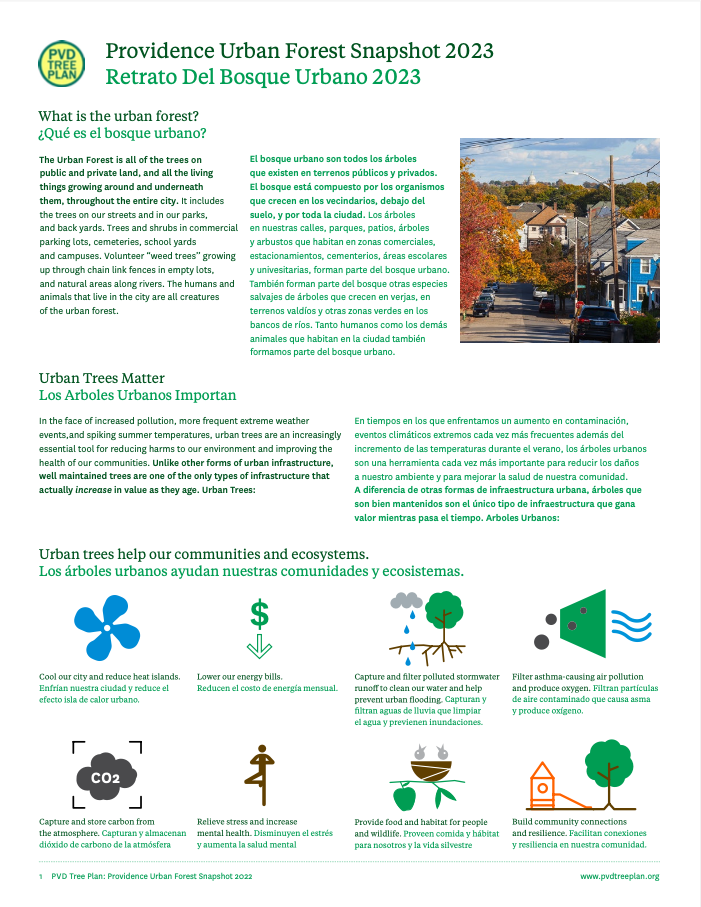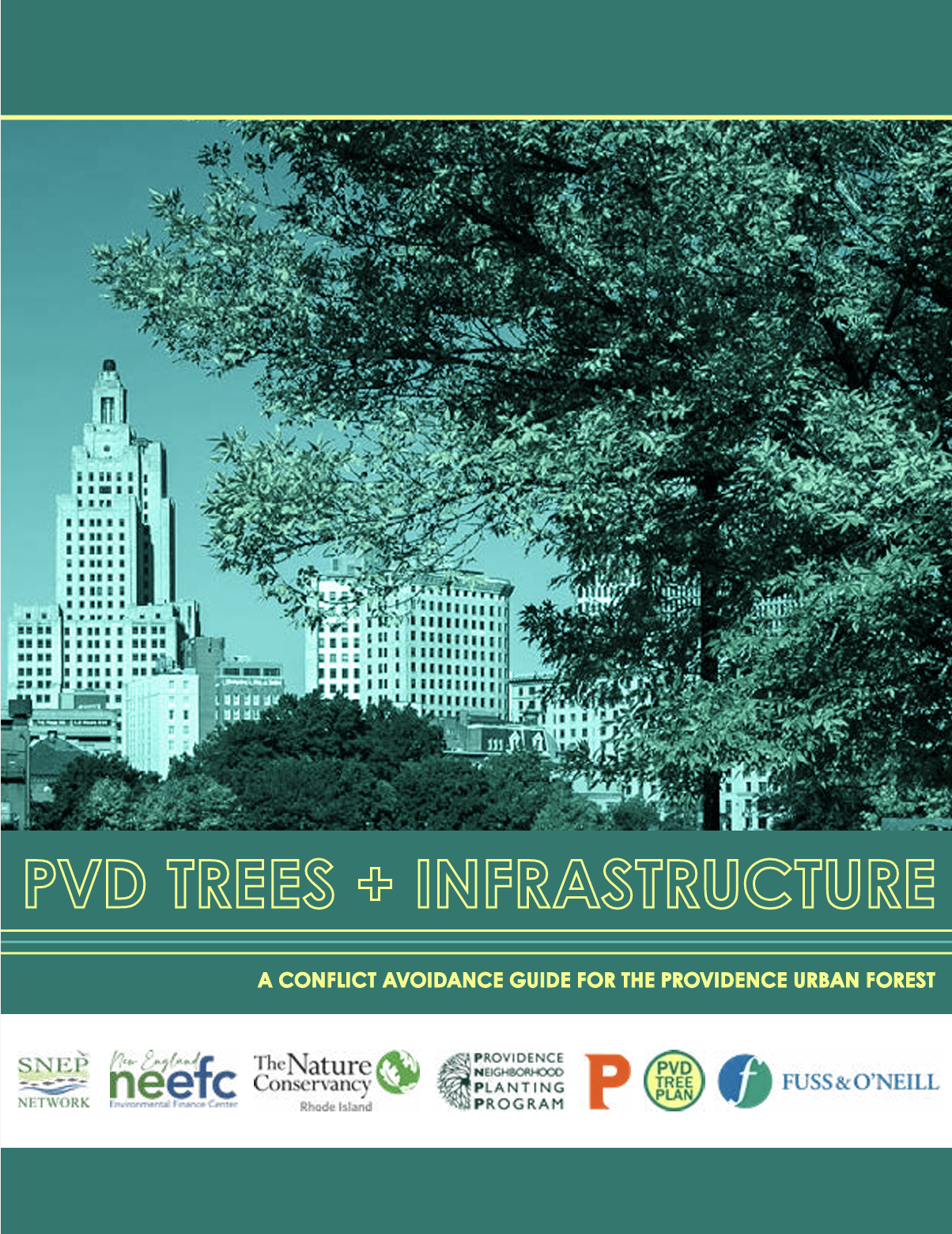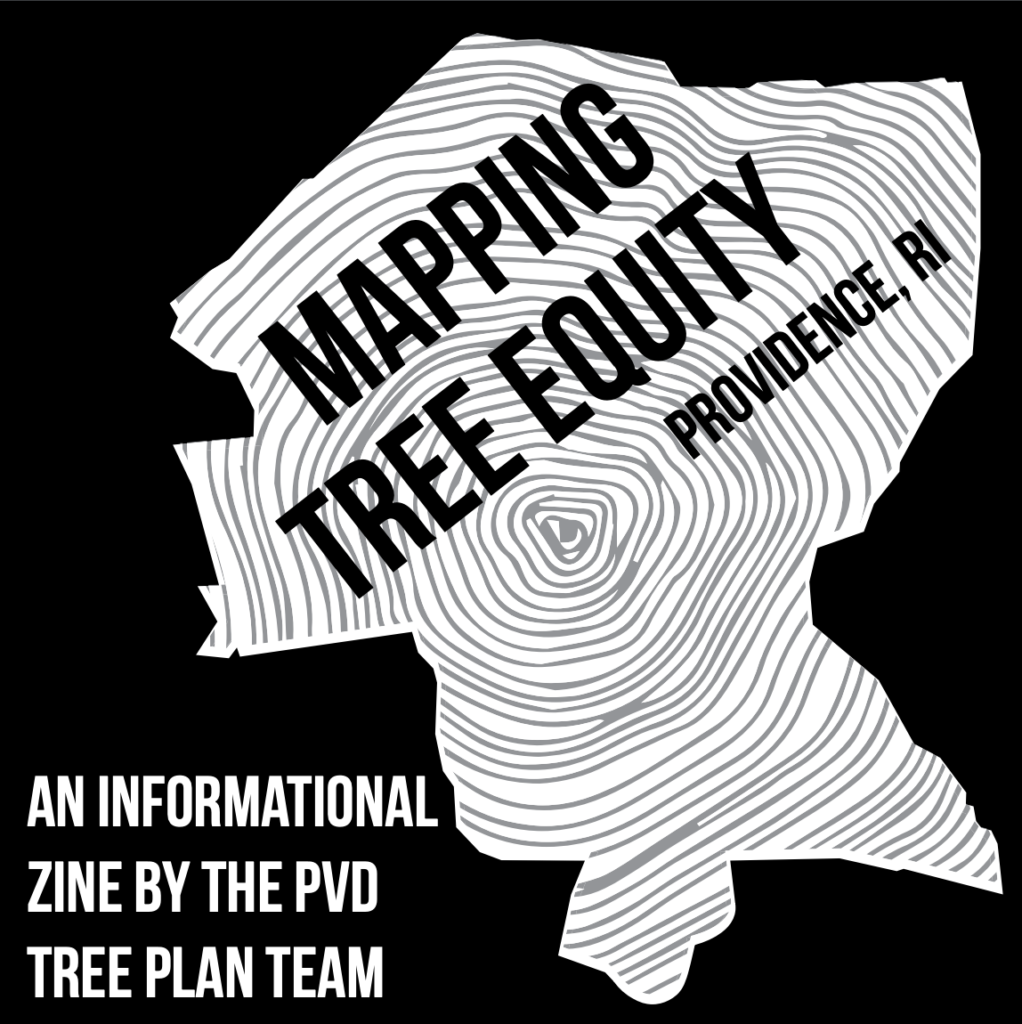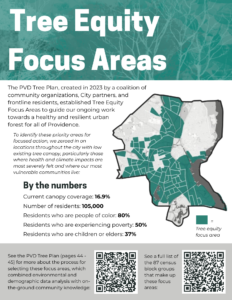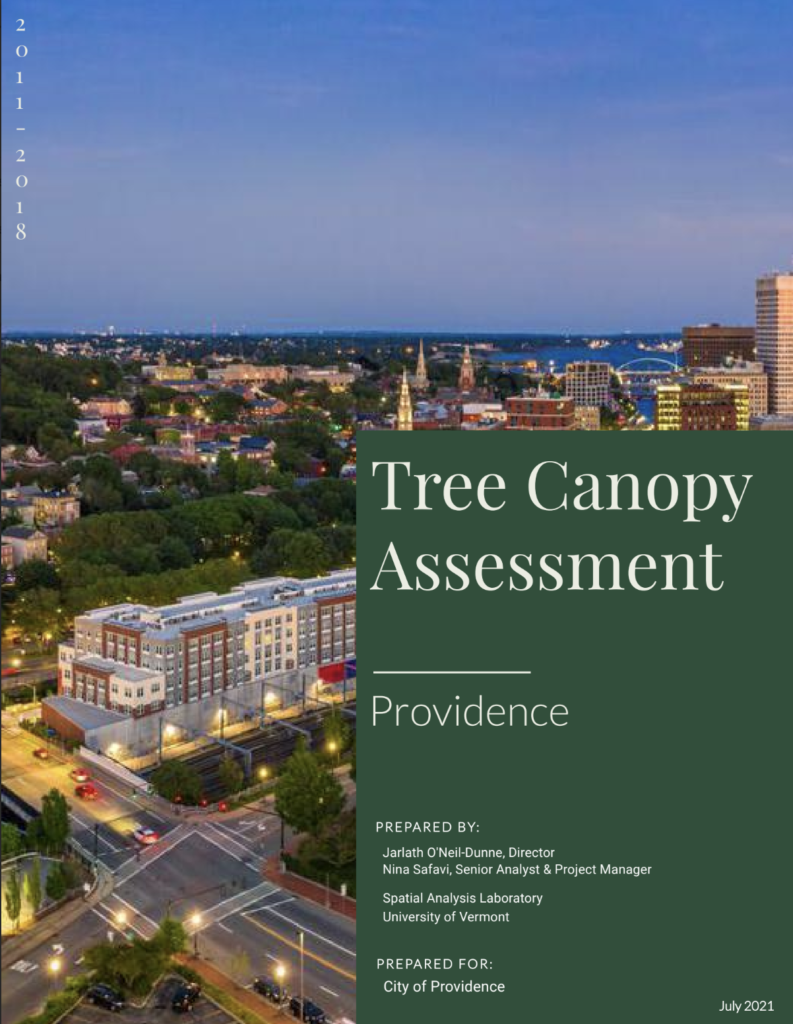
Resources
Planting & Maintenance Options
Are there tree needs in your neighborhood? Not sure what resources are available to you?
IF YOU WANT TO PLANT A TREE…
- Every spring and fall, the Providence Neighborhood Planting Program (PNPP) provides free trees for sidewalks and community gathering spaces, particularly those in Tree Equity Focus Areas. Reach out to PNPP to organize a planting with your neighbors for next season!
- To plant a sidewalk tree in an empty pit, you can apply for a free permit with the City Forestry Division to do it yourself! Limited match cost support is available.
- To plant a tree on private property, there unfortunately aren’t currently any programs in Providence to provide support… but you can check out PNPP’s how-to-plant-a-tree guide to learn how to do it yourself!
- Depending on the neighborhood, there might be funds available to support planting projects through partners like Groundwork RI or the Woonasquatucket River Watershed Council. Check here to see if you’re eligible for a free tree through Groundwork or reach out to PNPP to find out more.
IF A TREE NEEDS MAINTENANCE…
For example: tree or stump removal, fallen branch pick-up, branch pruning, or risk assessment
- If the tree is on public property (including sidewalks), call 311. A trained tree keeper or Forestry Crew will address the problem. Don’t try to do it yourself—this can’t be done without a permit!
- If the tree is on private property, there unfortunately aren’t currently any programs in Providence to provide support. See the list of suggested tree companies for hire below! NOTE: removing a tree bigger than 32 inches in diameter at 4.5 feet off the ground requires the permission of the City Forester!
- If you’re a business or institution looking for help with young tree stewardship or maintenance (including structural pruning or watering), consider hiring Garden Time’s Canopy Crew!
It takes time, energy, and money to grow a healthy urban forest, and these resources aren’t equally available to everyone. That’s why we’re working on creating new programs to support Providence residents in caring for trees. For now, the availability of support resources depends on a few things:
Private vs. Public Property: The City plants and maintains trees on public property, which includes sidewalks, parks, and public schools. Unfortunately, fewer resources exist for private property.
Tree Equity Focus Areas: The PVD Tree Plan has established “Tree Equity Focus Areas,” where tree canopy is currently low, for focused investment. More resources may be available to support planting and maintenance here.
RECOMMENDED TREE CARE COMPANIES
PVD Urban Forestry Documents
2023 Snapshot of Providence’s Urban Forest
These snapshots provide a brief overview of the importance of the urban forest and the state of our urban forest in Providence. With bilingual text in English and Spanish, they were created as an outreach tool during the PVD Tree Plan process.
Trees & Infrastructure: A conflict avoidance guide for Providence’s urban forest
This guide was produced with support from the Southeast New England Program Network to accompany the PVD Tree Plan. It presents potential tools, solutions, and recommendations to reduce conflicts between tree roots and sidewalks.
This zine uses maps to illustrate the connections between tree canopy and environmental racism in Providence. It was created by Movement Education Outdoors as an outreach tool during the PVD Tree Plan process.
Tree Equity Focus Areas Handout
This handout and map shows the areas of Providence that the PVD Tree Plan identified as being in need of prioritized attention, resources and investment, in order to create a more equitably distributed tree canopy in Providence.
2021 Urban Tree Canopy Assessment
This city-wide tree canopy assessment was commissioned by the City of Providence and performed by the Spatial Analysis Laboratory of the University Vermont. It used LiDAR data from 2011 and 2018 to illustrate the city’s existing tree canopy and analyze changes in tree canopy over seven years. Supplemental graphs are available here.
Climate and Health Species List of Rhode Island Urban Trees
This list was developed as part of the RI Urban Forests for Climate & Health Initiative to aid community forestry practitioners in selecting trees to reduce climate change vulnerability, reduce atmospheric carbon dioxide, and provide benefits to human health.
Caring for Our Urban Forest Brochure
This brochure outlines some of the key players in the network of individuals and organizations that stewards our urban forest… and how you can help!
Not sure if you want a new tree planted near you? Are you concerned about trees causing damage to sidewalks or making your allergies worse? In this brochure, PNPP talks through some of the most common concerns Providence residents have about trees.
Tree Plan Documents
Interactive Maps
American Forests, a national forestry nonprofit, has created several interactive map tools to help guide municipalities towards equity-focused urban forestry management.
Use the national explorer tool to find your neighborhood’s tree equity score and view up-to-date tree canopy information and demographic, health, and climate data at the census block group level or set up a free account to use the Rhode Island tree equity score analyzer and create custom tree planting scenarios at the property level.
Climate and Economic Justice Screening Tool
This tool was created by the National Council on Environmental Quality to identify communities that face disproportionate environmental burdens. It highlights “disadvantaged” census tracts based on climate, energy, health, housing, pollution, transportation, water, and workforce development data.
This national environmental justice screening and mapping tool from the EPA powerfully displays a wide range of environmental and demographic data sets, including:
- Pollution levels and sources
- Socioeconomic indicators including race, income, unemployment, and age
- Health disparities in life expectancy, heart disease, asthma, cancer, and disability
- Climate vulnerabilities, including flood risk, wildfire risk, and sea level rise
- Gaps in services including broadband, health insurance, transportation, and food access
It can also accommodate custom filters and areas of concern, compare those locations to the rest of the state, region, or nation, and overlay the locations of facilities such as schools, prisons, hospitals, public housing, and parks.
Extreme Heat Impacts in RI Health Equity Zones
This story map from the Rhode Island Department of Health shows heat vulnerability across the state’s Health Equity Zones, combining data on heat exposure and sensitivity.
Mapping Inequality: Redlining in New Deal America
This national project provides interactive, digitized copies of Home Owners Loan Corporation redlining maps for cities across the country, including Providence.
Curriculum & Career Resources
Urban Forestry Careers
Urban & Community Forestry Society Job Board
Urban Forestry Career Videos & Testimonials
K-12 Curriculum, Lesson Plans, and Activities
American Forests Tree Equity Curriculum: Exploring Green STEAM Careers
Books, Poems, & Music!
BOOKS
- The Book of Delights and Catalog of Unabashed Gratitude, by Ross Gay
- Braiding Sweetgrass: Indigenous Wisdom, Scientific Knowledge and the Teachings of Plants, by Robin Wall Kimmerer
- Dawnland Voices: An Anthology of Indigenous Writing from New England, edited by Siobhan Senier
- Emergent Strategy: Shaping Change, Changing Worlds, by adrienne maree brown
- Árboles Nuestros Para La Supervivencia, by María Benedetti
- How I Became a Tree, by Sumana Roy
- The Language of Trees: A Rewilding of Literature and Landscape, by Katie Holten
- Lessons from Plants, by Beronda L. Montgomery
- Old Growth: The Best Writing About Trees, from Orion Magazine
- Through Our Eyes: An Indigenous View of Mashapaug Pond, edited by Dawn Dove and Holly Ewald
POEMS
- “Instructions on Not Giving Up” and “61 Trees,” by Ada Limón
- “A Small Needful Fact” and “To the Fig Tree on 9th and Christian,” by Ross Gay
- “generations,” by Lucille Clifton
- “For Saundra” and “Walking Down Park,” by Nikki Giovanni
- “Speaking Tree,” by Joy Harjo
- “The Second Olive Tree,” by Mahmoud Darwish
- “You Must be Present,” by José Olivarez
- “The Liberators,” Pablo Neruda
- “The Deluge and the Tree,” Fadwa Touqan
- “Home and the Homeless,” Elizabeth Woody
- “The Forest for the Trees,” Rena Priest
- “Dream Variations,” Langston Hughes
- “The Love Tree,” Countee Cullen
- “When Great Trees Fall,” Maya Angelou
MUSIC
- “Vamonos,” by Kufa Castro
- “Pa Que Suba,” by Richie Oriach
- “Our Roots Run Deep,” by Dominique Fils-Aimé
- “BreathBox,” by Climbing Poetree
- “Journey Through the Secret Life of Plants”, by Stevie Wonder
Check out the appendix of the plan for additional links, documents, and resources!
Photo by Dominique Sindayiganza

